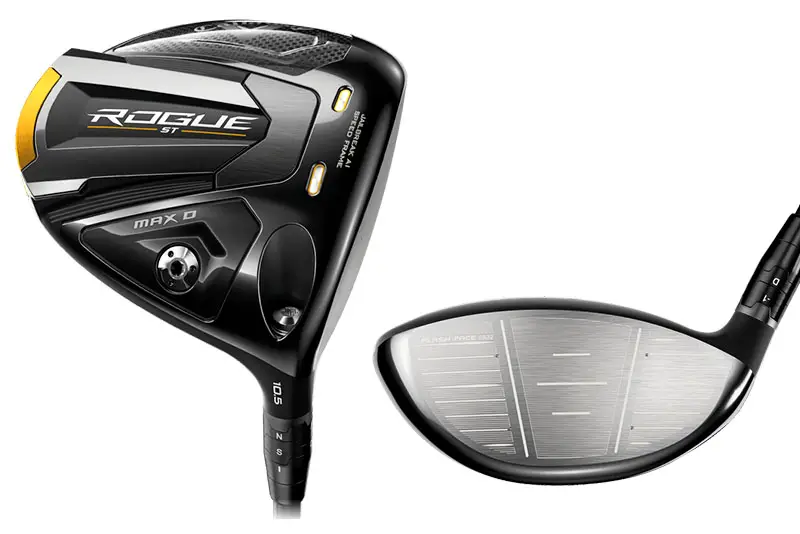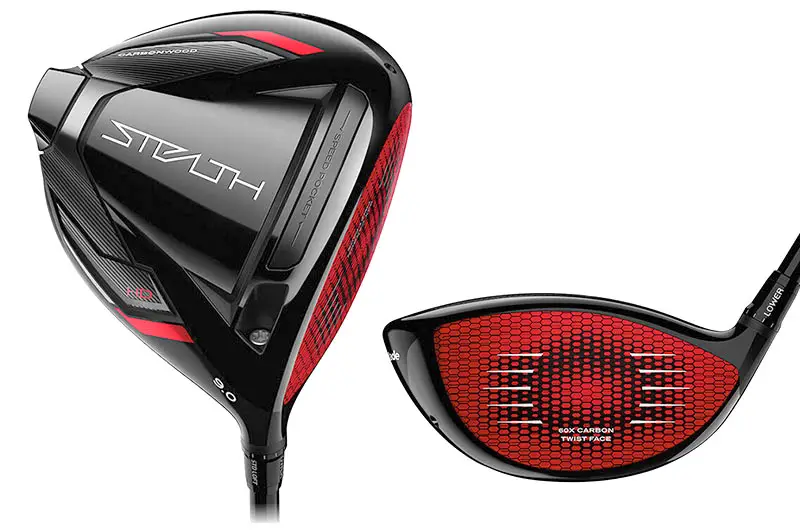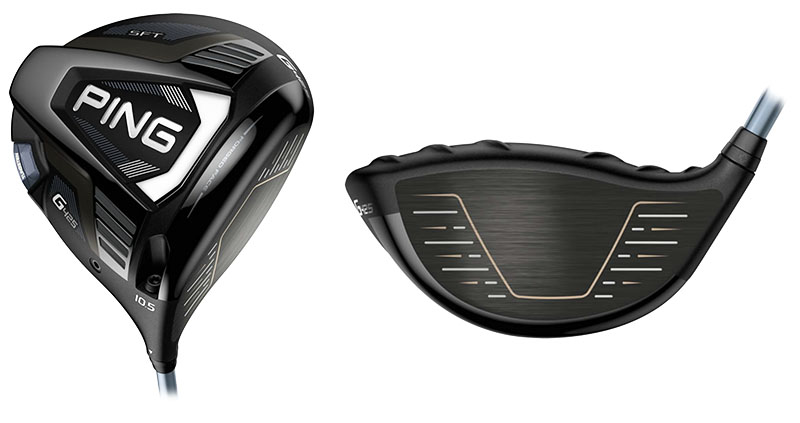
By Coach Erik Schjolberg – Jan 14, 2024
Contents
Key Takeaways
- Rogue ST Max D is the Draw Bias offering of the new Rogue lineup
- As a dedicated Draw driver, this club is best for higher handicap players
- Reduced face progression and upright lie help battle the slice
- Extra weight port at the heel naturally pushes your swing path in to out
- 20g tungsten speed cartridge at the rear boosts MOI and launch
You guessed it… D stands for Draw-bias. The Callaway Rogue ST MAX D Driver is Callaway’s quick fix for those that are fighting a slice, or simply prefer to play a hard draw.
Based on the tried-and-true MAX platform, the D driver changes the weighting a bit to promote the desired anti-slice ball flight.
Callaway Rogue ST Max D Driver Review




Lofts Available: 9⁰, 10.5⁰, 12⁰
Clubs In Series: Callaway Rogue ST Max Driver, Max LS Driver, Max D Driver, and Triple Diamond LS Driver
Pros:
- Draw-biased weight balance
- Retains forgiveness despite the changes to weight and face
- Elongated face for inconsistent hitters that play out of the heel or toe
- The driver is not an extreme draw bias option (trust me, you don’t want it to be too extremely draw bias)
Cons:
- Sidespin can creep up and cost carry distance
- A bit less forgiving than the MAX
Lofts Available
9⁰, 10.5⁰, 12⁰
Handicap Range
14+, it’s a dedicated draw driver
Technical Review
Callaway builds off the MAX platform with the Rogue ST Max D driver that has a reduced face progression and a more upright lie built into the club. To the naked eye, the club has a slightly more stretched-oval shape to it than the MAX.
Players will also notice that there is a weight-port located right in the heel of the driver to nudge your swing path in to out.
The Rogue ST MAX D still has all the benefits of the MAX driver but provides the player with a maximum shot shape correction. Is it possible to still slice the ball? Yep, and it’s kind of fun to try, but the average player with a neutral swing will see a shape to their ball.
Unless I intentionally played a slice, every normal swing finished to the left of my start line.
From a more technical perspective, the Rogue ST MAX D has a 20-gram tungsten speed cartridge instead of the 26-gram cartridge of the MAX, but this doesn’t substantially change the overall weight of the club thanks to the weight port. From a fit and feel perspective, they play comparable.
Stock swing weight is D3. Stock shaft options include the Fujikura Ventus Blue, Mitsubishi Tensei AV Blue, and Project X Cypher Black.
Performance
The fit and feel of this driver are remarkably similar to the MAX series—and rightfully so. Both drivers are designed on the same platform.
The visualization of the longer face gives a little bit more confidence that you will strike the ball well and move it in the direction you’re planning for.
Hitting this driver was a fun experiment, especially on course, but it’s not designed for my swing. Everything finished to the left of my start-line and target zones which changed the way I had to play holes. If nothing else, it’s a testament to how well the weighting of the driver works.
Having said that, if you already have a draw shot shape, the driver may produce too much side spin which will cut into your carry or leave you behind a tree on the left side of the hole.
In my hands, spin rating jumped up to around 2,750rpm on average with a significant left curve and reduced carry by about 25 yards. While the ball still ran out an extra 40 yards, it was often hampered by rough or water hazards which presented additional challenges on course.
Compared to other draw-biased drivers on the market, the Rogue ST MAX D driver has a more mild, playable draw in the average set of hands. I think a lot of people will like this driver for the security it brings to the table.
Looks
There are three noticeable differences between the MAX and the Rogue ST MAX D Driver. The first is the obvious weight-port at the bottom of the club.
The second that we’ve already mentioned is that the driver face is a bit more shallow and elongated than the ST MAX D driver. Players that often hit the ball out of the toe or heel will feel a bit more confident with the real estate available.
The third (slightly) noticeable change from the MAX is a touch more offset in the MAX D. Eighty percent or more of players won’t even see the difference, but for those that are particular about their setup and alignment, the ball will be framed a bit differently.
Sound and Feel
As with looks, there isn’t too much variation here from the MAX.
The Rogue ST MAX D has a similar lower-pitched sound report off the center of the face while still retaining positive feedback characteristics. I thought it had the highest pitch of the ST line, but not significantly so.
You will be able to tell when hitting out of the heel or the toe fairly easily while the center of the club retains more of a muted feel. Players that deploy this driver will appreciate the extra feedback on off-center shots.
Pros
- Elongated face for inconsistent hitters that play out of the heel or toe
- Draw-biased weight balance
- Retains forgiveness despite the changes to weight and face
- The driver is not an extreme draw bias option (trust me, you don’t want it to be too extremely draw bias)
Cons
- Sidespin can creep up and cost carry distance
- A bit less forgiving than the MAX
The Bottom Line
Callaway chose to make four drivers in this rendition of the Rogue, and it’s with good reason. The Rogue ST MAX D Driver gives players an option to play a dedicated shot shape, or to fight their existing one.
I liked the Rogue ST MAX D driver because it didn’t do anything extreme that became unplayable (looking at you Stealth HD!), and was still pleasant to the eye.




Lofts Available: 9⁰, 10.5⁰, 12⁰
Clubs In Series: Callaway Rogue ST Max Driver, Max LS Driver, Max D Driver, and Triple Diamond LS Driver
Pros:
- Draw-biased weight balance
- Retains forgiveness despite the changes to weight and face
- Elongated face for inconsistent hitters that play out of the heel or toe
- The driver is not an extreme draw bias option (trust me, you don’t want it to be too extremely draw bias)
Cons:
- Sidespin can creep up and cost carry distance
- A bit less forgiving than the MAX
Alternate Choices to the Callaway Rogue ST Max D (Draw Bias) Driver
TaylorMade Stealth HD


This one is a bit more of a “draw-biased” option. If you’re battling an extreme slice and just can’t figure out how to shake it, this TaylorMade draw driver may be your saving grace.
Ping G425 SFT


The SFT is probably a little closer to the Rogue ST Max D than the Stealth HD is. But again, a different club with different pros/cons… so read our review of the Ping G425 SFT Driver if you’re interested in that club.
Best Drivers for a Slice


Honestly, we do have an entire “top 5” review and ranking of the best driver for a slice. You’ll see some familiar and some not so familiar “surprises” on our list, if you want to give that a skim.
Other Callaway Rogue ST Drivers
There are actually 3 more drivers in the Rogue ST family that may fit you better depending on your specific needs…
- Callaway Rogue ST Max – best for beginners and mid handicap but without the draw bias
- Callaway Rogue ST Max LS – best for lower handicap players who have a higher swing speed
- Callaway Rogue ST Triple Diamond LS – best for tour players and sub zero handicap golfers
FAQ
Note – Some of these FAQs were covered throughout the article, but I still get these questions a lot… so here are the “short and sweet” answers to the most common questions:
Does Callaway Rogue ST Draw driver work?
Yes, the Callaway Rogue ST Draw driver works in the sense that it promotes more of a “draw bias” shot shape. This is going to drastically help those who just simply can’t rid themselves of the dreaded banana slice off the tee.
What is the difference between the Rogue ST and Rogue ST Draw driver?
The difference between the Rogue ST and Rogue ST Draw is simple, the draw version uses a different weight profile throughout the driver head to promote a draw bias ball flight.
What are the Callaway Rogue Draw Driver Adjustments?
- Loft can be adjusted 1 degree less or 2 degrees more than the stated loft
- Lie can be adjusted to either a standard lie, or a flat lie (2 degrees flatter)




Lofts Available: 9⁰, 10.5⁰, 12⁰
Clubs In Series: Callaway Rogue ST Max Driver, Max LS Driver, Max D Driver, and Triple Diamond LS Driver
Pros:
- Draw-biased weight balance
- Retains forgiveness despite the changes to weight and face
- Elongated face for inconsistent hitters that play out of the heel or toe
- The driver is not an extreme draw bias option (trust me, you don’t want it to be too extremely draw bias)
Cons:
- Sidespin can creep up and cost carry distance
- A bit less forgiving than the MAX

